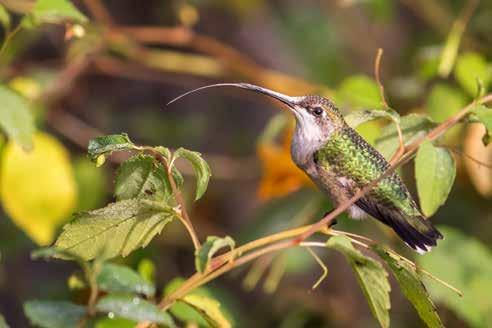
7 minute read
East Tennessee Wildlife: Throated Hummingbird


Advertisement
Photographing the beauty of Tennessee, and the wildlife who call it home.
By kalley cook
Hummingbird Tongue - A Ruby-Throated Hummingbird male can extend its tongue a distance equal to their bill, while the female’s is even longer. They can flick their tongues into nectar 12 times per second. Their tongue is forked at the end and when they pull their tongue back in from a flower or feeder, the tips come together at the end and roll inward, which traps the nectar. When the tongue is at rest, it wraps around inside the bird’s skull since it’s so long!
Hummingbird with Jewelweed - Hummingbirds will pick flowers over your feeders when flowers are more plentiful, so don’t be stressed if they aren’t at your feeders during spring. They also need to eat gnats and small bugs for protein. Hummingbirds are the only birds in the world that can fly backwards, and those wings beat 50 times a second, which is always hard to capture those wings still in a shot!
Loren E. Plemmons ATTORNEY AT LAW

Spring is here, which means our Ruby-Throated Hummingbirds should be returning from their winter retreat is in Central America or Mexico. Yay! It’s hard to imagine a little hummingbird flying that far from Tennessee! If you’ve happened to have a hummingbird that decided to stay here all through the winter, it’s possible that you’ve had a Rufous Hummingbird or another western species, which does happen. Some people will purposely leave out their feeders in the winter just in case a western hummingbird does stop by. Just something to keep in mind for next time!
The best solution for your feeders is 1 cup sugar with 4 cups boiling water, mix and let cool before filling the feeder. The rest can be stored in the refrigerator for next time. It’s important to clean your feeders every other day and clean thoroughly to prevent mold. Poorly managed feeders harm our precious hummingbirds more than most realize. Whether you make your own solution or purchase it, it’s important NOT to use red dye! They don’t need it to see your feeders, and this does more harm than good. Hummingbirds are so small, the amount red dye ingested would be (ounce for ounce) 17 times of what has been approved by the FDA for humans.
These delightful creatures always bring me so much joy, as I know they do to many other people, and I can’t wait for their return every
Contact: Kalleybcook@gmail.com www.facebook.com/kalleycookphotography kalleycook.smugmug.com
Coming into Rest - They don’t rest often, and because they burn so much energy, they need to feed every 10-15 minutes to survive. After dusk, they go into an intensely deep sleep called topor. This helps to conserve energy, and their heart rate will drop to 50 beats per minute instead of the normal 1200 beats per minutes during the day. While I have more photos of female ruby-throats, which you can identify by the white streak behind her eye and the grey streaking on throat, I believe we all know where they get their names from - the beautiful ruby throat on the males.
Though wildlife and nature photography hold her heart, you can contact Kalley for all of your photography needs, including sports, portraits, still life, food, real-estate, weddings, and photojournalism.

Kalley uses a Canon 7d markii, paired with a Canon 100-400mm lens for all of her photos.
You can purchase photos or prints of Kalley’s wildlife photography on a variety of products (mugs, mousepads, magnets, etc.).
Have a favorite animal that you’d like some text included? Custom orders welcome. Just go to https://kalleycook. smugmug.com or email Kalley. Shipping is available.
By lisa gRugin
Yes, I know you have plants in your yard that still look terrible. I do, too. I walk through of my yard and the Meadow View grounds at least once a week to check branches for flexibility. So far, they are all pliable, which means they are still alive. If yours are too, or if you have done the scratch test and there is still green under the bark, leave them alone. They are already stressed, and anything you do adds more stress. If you must fertilize, use an organic product that won’t force growth. If you must prune, stop as soon as you get to live wood. If you have questions, give us a call or stop by.
If you are not from this area, please be aware that this has not been typical weather. While the abundant sunshine is great for my mental health, I am worried because we have plants that are 3-4 weeks further ahead than they should be at this time. That means they are very vulnerable to cold damage. I am waiting to see what the mid-March temperatures in the 20s did, if my fears came true, you will be doing even more damage control, or everything will be fine. I’m hoping for the latter but was prepared for the former by covering my vulnerable plants.
Here is a list of things you need to do this month:
• If you haven’t done your walk around, this is the time. Take a close look at your plants to see what is recovering well and what isn’t. Remember that most professionals are suggesting that you give your plants until late May or even June to perk up. Patience is a gardener’s best tool.
• There are other issues to look for in addition to freeze damage. What has insect damage? What has fungal spots from last year? What needs to be pruned, divided, transplanted, or composted? Have things changed in the area? Make plans for what you want to get done this year and take those first steps.
• We have been seeing new and problematic insects the last couple of years, such as Crape Myrtle Bark Scale. Please call us if you think you have those. Many bugs are either benign or helpful, however, so don’t start drenching your plants in insecticide at the first sign of movement. Don’t hesitate to bring in samples if you have questions.
• If you saw fungal damage during your checkup, make sure you get any diseased leaves up and cleaned away. That will help prevent future problems. Plants that are prone to fungal problems, such as roses, will need constant vigilance and preventative measures.
• Get your planting beds ready if you have not already done so. Work in compost or aged manure to add nutrients. Get weeds out and apply a pre-emergent to make your life easier; however, do not use a pre-emergent if you are going to plant seeds!

• You are safe planting any of the cool season vegetables, but wait until midApril for tomatoes, peppers, and corn. Super sweet varieties of corn should wait until the soil is around 70 degrees, which is usually early May.
• Bedding plants are usually safe to plant by mid-month if Mother Nature is cooperating. If the weather is still erratic, it is safest to wait until later in the month to plant hollow stemmed annuals such as impatiens and begonias. They tend to turn to mush with a frost. Other annuals are more tolerant. Ask us if you have questions.
• Get your containers ready for spring. If they are large or have permanent occupants (shrubs, perennials, etc.), you do not have to dump the dirt out every year. Top dress them with a couple of inches of compost or fresh soil instead. After 3-5 years, you really need to take everything out and start all over.
• If they are small, dump the soil out and rinse the pot. If the plants had any fungal problems, mix a tablespoon of bleach into a gallon of water and pour it into the pot, then rinse it out. Refill the container with fresh, good quality soil that is specifically for containers. I use Fox Farm, Fafard, or EarthMix.
• If some of your spring blooming shrubs and trees need a trim, do that within a couple of weeks after they finish blooming. Please educate yourself! Permanent damage can be done by careless whacking.
• Don’t cut bulbs back until after the foliage has yellowed so they can store up nutrients for next year. BulbTone or Bone meal helps.
Please stop in with any questions, check our website for workshops or just to look at all the gorgeous stock we have in. Beautiful gardens begin here!
Meadow View Greenhouses & Garden Center 9885 Highway 11E Lenoir City, TN 37772 865.986.7229 www.meadowviewgreenhouse.com
Weatherproof All of Your Out-of-Door Events
It’s time to move your family’s events back outdoors, and the professionals at Undercover Systems can provide you with the unlimited out-of-door options that your family can enjoy all year-round.
Spring is the perfect time to install Undercover Systems’ totally unique underdecking ceiling system under your home’s existing raised decks. This totally proprietary and patented underdeck system will ensure that this year’s events will be protected from unexpected and unwanted rain, the searing summertime sun, and wintertime sleet and snow.


“Spring is a great time to weatherproof all of your future out-of-door events,” said Jim Conn, owner of Undercover Systems. “Throughout the entire process, our skilled craftsmen work with you each step of the way, from consultation to project completion, until you are completely satisfied. And because each underdeck system we install is custom made by Undercover Systems specifically for your home, you can be assured of many years of reliable, trouble-free family enjoyment. Most competitive systems use generic, off the shelf components found at the big home improvement box stores. Homeowners also appreciate the fact that their new underdeck system is totally supported by Undercover Systems’ gutters and not your home’s deck as with competitive systems. This promotes greater deck air circulation and deck longevity.”
You’ll also appreciate Undercover Systems’ attention to detail, which comes from years of experience, as they help you craft a seamless transition from your home’s interior to your new out-of-door living spaces, which will perfectly complement your existing architecture and landscaping plan.
A complaint-free member of the Better Business Bureau, Undercover Systems offers you the peace of mind that you deserve in a building contractor.

Why not surprise your family this season with a special springtime gift that the entire family can enjoy all year long and start creating a lifetime of memories? Call Jim Conn today at 423-267-0091 and start celebrating every season out-of-doors.
Undercover Systems
423-267-0091 www.UndercoverSystems.com










